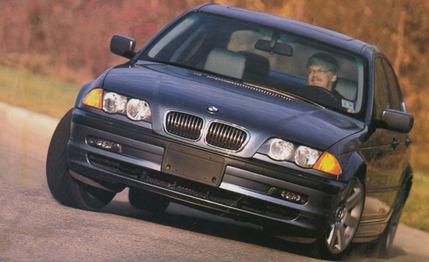
 Long-Term Road Test
Long-Term Road Test
At 18,380 miles, a curious thing happened to our 1999 BMW 328i long-term car. God, with that mysterious sense of humor that is only His, caused a tree to leap into the path of our redoubtable Bimmer. A tree, we should add, of substantial girth and limb. A tree unlikely to give so much as an inch in an unpleasant encounter with, oh, a cement truck, let alone a mere 3328-pound sports sedan.
The tree wasn't going all that fast when it jumped in front of the car. Aside from abrasions caused by the airbag, the driver walked away without injuries of any kind, except ones involving the ego. She has since become a little jumpy in arboreal settings, the first genuine oakophobe we've ever known.
In any case, the relatively low speed of the encounter, the absence of injuries, and the condition of the car -- at a glance, it didn't really look all that bad -- made the repair tab a real shock: $28,458.
Wow. Once you've wrapped your mind around that sum, you probably find yourself asking two questions, just as we did.
No. 1: How could it possibly cost that much?
No. 2: If it was that bad, why wasn't the car declared a total loss?
The answers:
No. 1: When you start a piecemeal replacement of components on any car, it doesn't take long to run up a pretty good-sized bill. In this case, the list included just about everything from the A-pillar forward, although the engine and transmission were not injured. Even though the single largest payment was only $799 -- for a new power-steering rack -- the list was lo-o-o-ong. The bill ran to 11 pages, with the parts, for once, adding up to more than the labor: $14,778 for the hardware and $11,898 for the manpower to put them properly in place. The taxes cost more than a set of good tires -- $928. Materials: $696. Subcontracted detail work: $140. Other miscellaneous items: $18.
No. 2: Although the grand total was formidable, it still fell short of this Bimmer's value. The base price of a 1999 328i was $33,970. Ours, however, had a few extras. Adding $1350 to the sticker was the always desirable Sport package, consisting of 17-inch aluminum alloy wheels, P225/45WR-17 Continental ContiSport Contact tires, firmer suspension components, sport seats, and a three-spoke, leather-wrapped sport steering wheel. Supple gray leather upholstery was $1450. A power glass sunroof was another $1050. Split-folding rear seats with ski bag: $575. Heated front seats: $500. Steel Blue Metallic paint: $475. CD player: $200. Luxury tax: $94. Total price as tested: $39,664.
So the insurance folks decided to fix it.
Which brings us to the amazing part.
Ordinarily, when you rebuild something by hand, there's a good chance it's not going to look as good or function as well as the original produced in the factory. As proof, just look at Frankenstein. Not so good, right? But when our Bimmer finally came home, after a rehab that took a little more than three months, it was as good as new. Literally. We did replace the clutch, but that came after the car had passed the 40,000-mile finish line of all our long-term tests. The clutch had begun to slip during the car's final acceleration tests at the nearby proving ground.
But in all other respects, the resuscitated 328i looked and performed as well as it did when it rolled into the C/D Hogback Road paddock, brand-new, in April 1999. It tracked straight and true, its twin-cam straight-six engine pulled with the same smooth, hydraulic urgency that's so uniquely BMW, and it was devoid of the buzzes, squeaks, and rattles so common after major car surgery.
We attribute this to two factors. First, it's clear that the good-hands people at Autometric Collision in Pontiac, Michigan, know their business. Their restoration work was flawless. Second, we think the results indicate that BMWs are made of pretty tough stuff.
A little history: Already modestly updated for the 2001 model year, our test car represents the fourth generation of BMW's popular 3-series line, known internally as E46. The latest redesign was introduced for the 1999 model year, with a chassis that was stiffer and longer (an extra inch of wheelbase). Although the styling changes were subtle, it's a bigger car -- 1.5 inches longer, 1.6 inches wider, and almost an inch taller -- than its predecessor, and all its sheetmetal is new. It's also roomier, with an instrument panel and interior trim that more closely resemble those in the more expensive 5- and 7-series Bimmers.